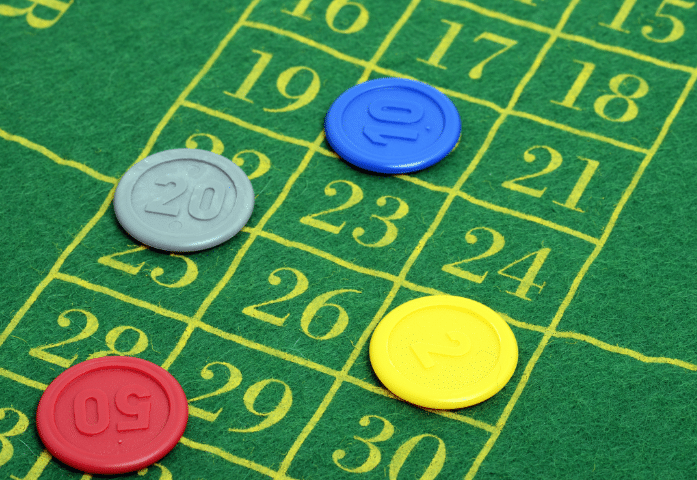March 1, 2021
Roulette Terms Explained (With Examples)

New to online roulette? Check out our glossary of common roulette terms — types of bets, payout details, and special rules — to help you get started on the right foot.
While roulette itself is a straightforward game, it comes with a lot of terminology and slang that can be hard for beginners to navigate. If you can learn the basics of roulette lingo, you’ll fare much better as you continue to play, and you’ll be able to keep track of what’s happening around you.
We’ve compiled an alphabetical glossary of roulette terms for you to refer to when you need it. We’ll cover types of bets, payout details, and some special rules you should keep an eye out for.
American Wheel
This is a version of the roulette wheel that has 38 pockets: 1-36 as well as a 0 and 00. The American wheel creates a much higher house edge than the European, or French, wheel.
Bankroll
This refers to the total funds that a player has set aside to use during a game. For example, you might allow yourself $500 to gamble with — no more and no less. This is your total bankroll for the game.
Biased Wheel
This happens when a wheel has a defect that results in some numbers getting hit more often than normal probability would allow. Through age and wear, some wheels start to get chips or dents that can affect where a ball lands. Plenty of people have tried to find biased wheels to exploit and win big. If you keep seeing the ball land on certain numbers again and again (like 22), then you might be faced with a biased wheel.
Croupier
This is the more formal French term for the roulette dealer. This is the person who spins the wheel, collects bets, and distributes winnings for the table. If you’ve spent a while at a roulette table, etiquette expects you to tip the croupier ($5 per hour of play is acceptable).
‘En Prison’ Rule
This is a special rule in French roulette that applies only to even-money bets. When the ball lands on 0, the player doesn’t automatically lose. Instead, they have two options:
- They can reclaim half of their bet and lose the other half.
- They can leave the money “in prison” for another spin. If they win on that second spin, the player gets their whole original bet back.
European (or French) Wheel
This style of roulette wheel is most commonly found in European and Asian casinos. In contrast to the American wheel, the European wheel has pockets for 1-36 and a single 0. This lowers the house edge considerably, making it a more sought-out style of roulette for many players.
Even Money
Even-money bets pay 1-1. These are the lowest-risk bets to make in roulette, so their payout ratios are also low. Red/Black, Even/Odd and High/Low are all even-money bets. To explain: If you bet $10 on red and you win, you’ll make back your bet of $10 and earn an additional $10. So you’ve profited $10 on that one spin.
House Edge
The house edge is the casino’s mathematical advantage over the player and how they guarantee their ability to make a profit. It’s framed as the percentage of each bet that the casino will keep in the long run.
On European/French wheels, the house edge is 2.7% (meaning that, per $100 bet over time, the casino will earn an average of $2.70). On American wheels, that house edge jumps to 5.26% (or, per $100 bet over time, the casino will earn an average of $5.26).
Inside Bet
Players make inside bets when they place their chips on the central, numbered part of the roulette layout. Inside bets can be on individual numbers or on small groups of numbers at once.
These types of wagers pay out at higher odds. The opposite of an inside bet is an outside bet, defined later on in this article.
‘La Partage’ Rule
This is another special rule in French roulette, and it’s similar to the “en prison” rule. Here, if the player has made an even-money bet and the wheel lands on 0, that player gets back half of their money automatically and so loses only half of their original wager.
Layout
This is the design on the roulette table’s surface that has all of the numbers and different propositions organized. This is the area where players can place their bets on individual numbers, entire columns or rows of numbers, and propositions like red or black.
Minimum and Maximum Bets
Each roulette table has set amounts that can be bet on each spin of the wheel. These amounts are established as minimums and maximums that players can wager on inside and outside bets. The table should have a “table limit” sign with these numbers on them. You might see a sign that looks something like this:
- Minimum Inside Bet: $2
- Minimum Outside Bet: $5
- Maximum Inside Bet: $120
- Maximum Outside Bet: $2,500
To explain: If you want to make an inside bet (that means to bet on specific numbers), all of your bets must total at least $2. You could make two $1 bets or a single $2 bet. Meanwhile, the amount of bets that you wager on inside bets cannot go above that $120 threshold.
If you want to make an outside bet (to bet on a proposition like red or even numbers), all of your bets must total at least $5. You cannot break this up like you could with an inside bet — you have to bet at least the $5 minimum on each outside bet. At the same time, you cannot bet more than $2,500 on any outside bet in this scenario.
Physical casinos and online casinos will both have maximum and minimum bets clearly established for players to see. Oftentimes, online casinos will have lower maximum bets than live casinos.
Outside Bet
Players make outside bets when they place their chips on the outer blocks of the table’s layout. These encompass large sections of the roulette wheel as opposed to being direct bets on specific numbers. These include Red/Black, High/Low, and Even/Odd, as well as Dozen (where you bet on the first dozen, second dozen, or third dozen of the wheel’s numbers to win) or Column (where you bet on the first, second, or third column of numbers on the layout to have the winning number).
These types of bets have better odds but lower payouts.
Payout
This is the winning amount that the player gets from the casino. In roulette, some payouts can be rather low (like 1-1 or 2-1), while riskier wagers get higher payouts (all the way up to 35-1). To illustrate, if you wagered $10 on a 2-1 bet and won, you’d profit $20. If you wagered $10 on a 35-1 bet and won, you’d profit $350.
Remember These During Your Next Game
If you’re new to roulette, you can use this page as a reference to help you become more familiar with the ins and outs of this exciting game. You can also try playing online roulette to perfect your approach and try out some different betting styles.
Good luck!



